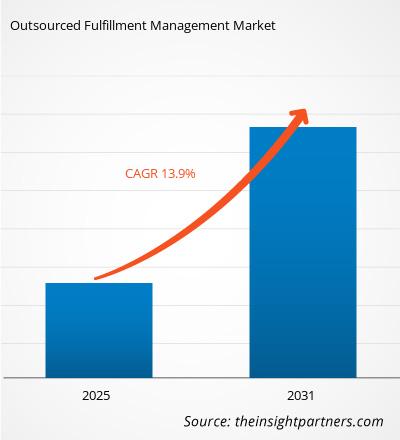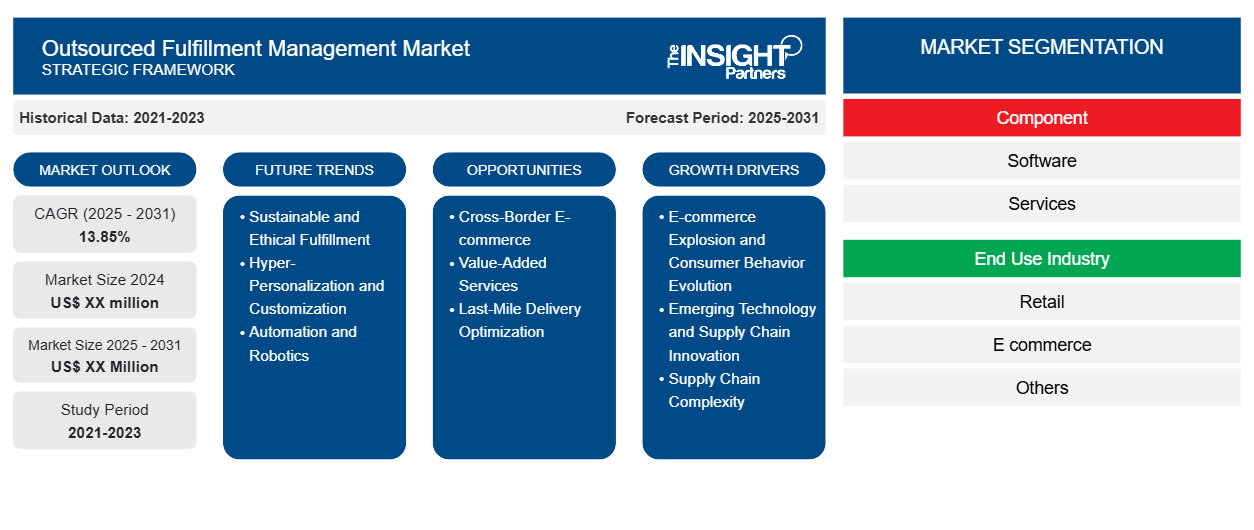Der Markt für ausgelagertes Fulfillment-Management wird voraussichtlich von 2023 bis 2031 eine durchschnittliche jährliche Wachstumsrate (CAGR) von 13,85 % verzeichnen, wobei die Marktgröße von XX Millionen US-Dollar im Jahr 2023 auf XX Millionen US-Dollar im Jahr 2031 wachsen wird.
Der Bericht ist in vier Abschnitte unterteilt: Komponente (Software, Dienste), Endverbrauchsbranche (Einzelhandel, E-Commerce, Sonstiges) und Anwendung (Lagerverwaltung, Nachverfolgung, Berichterstellung, Abrechnung, Sonstiges). Die Marktbewertung wird für die obige Segmentanalyse in US-Dollar angegeben.
Zweck des Berichts
Der Bericht Outsourced Fulfillment Management Market von The Insight Partners zielt darauf ab, die aktuelle Landschaft und das zukünftige Wachstum sowie die wichtigsten treibenden Faktoren, Herausforderungen und Chancen zu beschreiben. Dies wird verschiedenen Geschäftspartnern Einblicke geben, wie zum Beispiel:
- Technologieanbieter/-hersteller: Um die sich entwickelnde Marktdynamik zu verstehen und die potenziellen Wachstumschancen zu kennen, damit sie fundierte strategische Entscheidungen treffen können.
- Investoren: Durchführung einer umfassenden Trendanalyse hinsichtlich der Marktwachstumsrate, der finanziellen Marktprognosen und der Chancen entlang der Wertschöpfungskette.
- Regulierungsbehörden: Zur Regulierung von Richtlinien und Überwachungsaktivitäten auf dem Markt mit dem Ziel, Missbrauch zu minimieren, das Vertrauen der Anleger zu bewahren und die Integrität und Stabilität des Marktes aufrechtzuerhalten.
Outsourced Fulfillment Management Marktsegmentierung
Komponente
- Software
- Dienstleistungen
Endverbrauchsindustrie
- Einzelhandel
- Elektronischer Handel
- Sonstiges
Anwendung
- Bestandsverwaltung
- Sendungsverfolgung
- Berichterstattung
- Abrechnung
- Sonstiges
Geographie
- Nordamerika
- Europa
- Asien-Pazifik
- Süd- und Mittelamerika
- Naher Osten und Afrika
Geographie
- Nordamerika
- Europa
- Asien-Pazifik
- Süd- und Mittelamerika
- Naher Osten und Afrika
Passen Sie diesen Bericht Ihren Anforderungen an
Sie erhalten kostenlose Anpassungen an jedem Bericht, einschließlich Teilen dieses Berichts oder einer Analyse auf Länderebene, eines Excel-Datenpakets sowie tolle Angebote und Rabatte für Start-ups und Universitäten.
-
Holen Sie sich die wichtigsten Markttrends aus diesem Bericht.Dieses KOSTENLOSE Beispiel umfasst eine Datenanalyse von Markttrends bis hin zu Schätzungen und Prognosen.
Wachstumstreiber für den Markt für ausgelagertes Fulfillment-Management
- Explosion des E-Commerce und Entwicklung des Verbraucherverhaltens: Der E-Commerce hat um ein Vielfaches zugenommen und dies hat eine hohe Nachfrage nach effizienten und zuverlässigen Fulfillment-Diensten geschaffen. Die Verbraucher von heute suchen schnelle, fehlerfreie und problemlose Lieferungen und dies veranlasst Unternehmen, Fulfillment-Dienste zur Auslagerung an Drittanbieter zu vergeben.
- Neue Technologien und Innovationen in der Lieferkette: Die Integration von KI, maschinellem Lernen und IoT in Fulfillment-Dienste hat einen Wandel herbeigeführt. Die Technologien ermöglichen Echtzeit-Tracking, prädiktive Analysen und automatisiertes Bestandsmanagement. Zu den realisierten Vorteilen zählen effiziente Prozesse und Kostensenkungen.
- Komplexität der Lieferkette: Die Verwaltung komplexer Lieferketten kann insbesondere in einer globalisierten Wirtschaft eine Herausforderung darstellen, weshalb die Auslagerung der Auftragsabwicklung eine wertvolle Lösung darstellt.
Outsourced Fulfillment Management Markt: Zukünftige Trends
- Nachhaltige und ethische Auftragsabwicklung: Mit dem zunehmenden Bewusstsein für Umwelt- und Sozialprobleme steigt die Nachfrage nach nachhaltigen und ethischen Auftragsabwicklungspraktiken. Die ausgelagerten Auftragsabwicklungsanbieter müssen umweltfreundliche Verpackungsmaterialien verwenden, Versandrouten optimieren, um Kohlenstoffemissionen einzusparen, und faire Arbeitspraktiken sicherstellen.
- Hyperpersonalisierung und -anpassung: Personalisierung und Anpassung werden vom Verbraucher bis hin zu den Fulfillment-Prozessen ausgeweitet. Kunden erwarten maßgeschneiderte Erlebnisse, darunter personalisierte Verpackung, Produktbündelung und individuelle Lieferoptionen.
- Automatisierung und Robotik: Automatisierungstechnologien wie die robotergestützte Prozessautomatisierung (RPA) und Lagerroboter verbessern die Effizienz und Genauigkeit.
Marktchancen für ausgelagertes Fulfillment-Management
- Grenzüberschreitender E-Commerce: Das rasante Wachstum des grenzüberschreitenden E-Commerce bietet großartige Möglichkeiten für die Ausgliederung von Fulfillment-Diensten. Internationaler Versand, Zollabfertigung und die Einhaltung lokaler Vorschriften können zeit- und arbeitsintensiv sein.
- Mehrwertdienste: Über die einfache Lagerung und den Versand hinaus kann die ausgelagerte Auftragsabwicklung eine Reihe von Mehrwertdiensten bieten, die die Unternehmen von der Konkurrenz abheben und die Kundenzufriedenheit verbessern. Zu diesen Mehrwertdiensten können beispielsweise Produktmontage, Zusammenstellung, Etikettierung und kundenspezifische Verpackung gehören.
- Optimierung der Zustellung auf der letzten Meile: Eine wichtige Chance besteht in der Verbesserung der Effizienz der Zustellung auf der letzten Meile, einschließlich der Zustellung am selben oder nächsten Tag.
Regionale Einblicke in den Markt für ausgelagertes Fulfillment-Management
Die regionalen Trends und Faktoren, die den Outsourced Fulfillment Management-Markt während des Prognosezeitraums beeinflussen, wurden von den Analysten von Insight Partners ausführlich erläutert. In diesem Abschnitt werden auch die Marktsegmente und die Geografie des Outsourced Fulfillment Management in Nordamerika, Europa, im asiatisch-pazifischen Raum, im Nahen Osten und Afrika sowie in Süd- und Mittelamerika erörtert.

- Erhalten Sie regionale Daten zum Outsourced Fulfillment Management-Markt
Umfang des Marktberichts zum Outsourced Fulfillment Management
| Berichtsattribut | Details |
|---|---|
| Marktgröße im Jahr 2023 | XX Millionen US-Dollar |
| Marktgröße bis 2031 | XX Millionen US-Dollar |
| Globale CAGR (2023 - 2031) | 13,85 % |
| Historische Daten | 2021-2022 |
| Prognosezeitraum | 2024–2031 |
| Abgedeckte Segmente |
Nach Komponente
|
| Abgedeckte Regionen und Länder |
Nordamerika
|
| Marktführer und wichtige Unternehmensprofile |
|
Dichte der Marktteilnehmer für ausgelagertes Fulfillment-Management: Die Auswirkungen auf die Geschäftsdynamik verstehen
Der Markt für Outsourced Fulfillment Management wächst rasant, angetrieben durch die steigende Nachfrage der Endnutzer aufgrund von Faktoren wie sich entwickelnden Verbraucherpräferenzen, technologischen Fortschritten und einem größeren Bewusstsein für die Vorteile des Produkts. Mit steigender Nachfrage erweitern Unternehmen ihr Angebot, entwickeln Innovationen, um die Bedürfnisse der Verbraucher zu erfüllen, und nutzen neue Trends, was das Marktwachstum weiter ankurbelt.
Die Marktteilnehmerdichte bezieht sich auf die Verteilung der Firmen oder Unternehmen, die in einem bestimmten Markt oder einer bestimmten Branche tätig sind. Sie gibt an, wie viele Wettbewerber (Marktteilnehmer) in einem bestimmten Marktraum im Verhältnis zu seiner Größe oder seinem gesamten Marktwert präsent sind.
Die wichtigsten Unternehmen, die auf dem Markt für ausgelagertes Fulfillment-Management tätig sind, sind:
- Amware Fulfillment, LLC
- Lieferant
- eFulfillment-Dienst
- FedEx
- Rakuten Super Logistics
Haftungsausschluss : Die oben aufgeführten Unternehmen sind nicht in einer bestimmten Reihenfolge aufgeführt.

- Überblick über die wichtigsten Akteure auf dem Markt für Outsourced Fulfillment Management
Wichtige Verkaufsargumente
- Umfassende Abdeckung: Der Bericht deckt die Analyse von Produkten, Diensten, Typen und Endbenutzern des Outsourced Fulfillment Management-Marktes umfassend ab und bietet einen ganzheitlichen Überblick.
- Expertenanalyse: Der Bericht basiert auf dem umfassenden Verständnis von Branchenexperten und Analysten.
- Aktuelle Informationen: Der Bericht stellt durch die Abdeckung aktueller Informationen und Datentrends Geschäftsrelevanz sicher.
- Anpassungsoptionen: Dieser Bericht kann angepasst werden, um spezifische Kundenanforderungen zu erfüllen und die Geschäftsstrategien optimal anzupassen.
Der Forschungsbericht zum Outsourced Fulfillment Management-Markt kann daher dabei helfen, die Branchensituation und Wachstumsaussichten zu entschlüsseln und zu verstehen. Obwohl es einige berechtigte Bedenken geben kann, überwiegen die allgemeinen Vorteile dieses Berichts tendenziell die Nachteile.
- Historische Analyse (2 Jahre), Basisjahr, Prognose (7 Jahre) mit CAGR
- PEST- und SWOT-Analyse
- Marktgröße Wert/Volumen – Global, Regional, Land
- Branchen- und Wettbewerbslandschaft
- Excel-Datensatz
Aktuelle Berichte
Verwandte Berichte
Erfahrungsberichte
Grund zum Kauf
- Fundierte Entscheidungsfindung
- Marktdynamik verstehen
- Wettbewerbsanalyse
- Kundeneinblicke
- Marktprognosen
- Risikominimierung
- Strategische Planung
- Investitionsbegründung
- Identifizierung neuer Märkte
- Verbesserung von Marketingstrategien
- Steigerung der Betriebseffizienz
- Anpassung an regulatorische Trends























 Kostenlose Probe anfordern für - Markt für ausgelagertes Fulfillment-Management
Kostenlose Probe anfordern für - Markt für ausgelagertes Fulfillment-Management